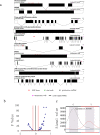Genome-wide association analysis identified molecular markers associated with important tea flavor-related metabolites
- PMID: 33642595
- PMCID: PMC7917101
- DOI: 10.1038/s41438-021-00477-3
Genome-wide association analysis identified molecular markers associated with important tea flavor-related metabolites
Abstract
The characteristic secondary metabolites in tea (theanine, caffeine, and catechins) are important factors contributing to unique tea flavors. However, there has been relatively little research on molecular markers related to these metabolites. Thus, we conducted a genome-wide association analysis of the levels of these tea flavor-related metabolites in three seasons. The theanine, caffeine, and catechin levels in Population 1 comprising 191 tea plant germplasms were examined, which revealed that their heritability exceeded 0.5 in the analyzed seasons, with the following rank order (highest to lowest heritabilities): (+)-catechin > (-)-gallocatechin gallate > caffeine = (-)-epicatechin > (-)-epigallocatechin-3-gallate > theanine > (-)-epigallocatechin > (-)-epicatechin-3-gallate > catechin gallate > (+)-gallocatechin. The SNPs detected by amplified-fragment SNP and methylation sequencing divided Population 1 into three groups and seven subgroups. An association analysis yielded 307 SNP markers related to theanine, caffeine, and catechins that were common to all three seasons. Some of the markers were pleiotropic. The functional annotation of 180 key genes at the SNP loci revealed that FLS, UGT, MYB, and WD40 domain-containing proteins, as well as ATP-binding cassette transporters, may be important for catechin synthesis. KEGG and GO analyses indicated that these genes are associated with metabolic pathways and secondary metabolite biosynthesis. Moreover, in Population 2 (98 tea plant germplasm resources), 30 candidate SNPs were verified, including 17 SNPs that were significantly or extremely significantly associated with specific metabolite levels. These results will provide a foundation for future research on important flavor-related metabolites and may help accelerate the breeding of new tea varieties.
Conflict of interest statement
The authors declare that they have no conflict of interest.
Figures





References
-
- Yamanishi T. Flavor of tea. Food Rev. Int. 1995;11:371–546. doi: 10.1080/87559129509541049. - DOI
-
- Zhang W, et al. The effects and mechanisms of epigallocatechin-3-gallate on reversing multidrug resistance in cancer. Trends Food Sci. Tech. 2019;93:221–233. doi: 10.1016/j.tifs.2019.09.017. - DOI
-
- Liang Y, Shi M. Advances in tea plant genetics and breeding. J. Tea Sci. 2015;35:103–109.
LinkOut - more resources
Full Text Sources
Other Literature Sources

